A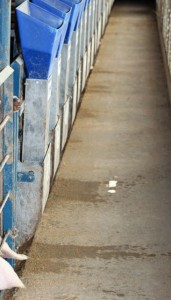 couple of weeks ago I received a call from Fritz Richards, Hog Slat’s national sales manager. Next time you are in North Carolina we need to run out to TDM #29 and take a look at the way they are utilizing a SowMAX feeder for feeding weaned sows.” It just so happened I was going to be in North Carolina the following week so I met Fritz at his office and we set out for the farm. As we drove he filled me in. “They have adapted 30 of the breeding row stalls with small bowl feeders and SowMAX dispensers mounted in the front gate. It’s giving them a chance to compare the results against the other 70 stalls that are fed by the standard method.” “What is the thinking behind that?" I asked. “They know that if they can increase the energy intake of a sow from weaning to first service they will get production benefits. The problem has been it’s tough to increase consumption without over feeding and wasting feed. With the high cost of feed it’s more important than ever to feed sows correctly without wastage.” “We have had several industry production advisors through the farm recently and they were very positive about what they saw.” We showered into the farm and happened to catch the unit manager, Britt Hooper and his staff during their morning break. Fritz spoke with Britt about his early experiences with the SowMAX test. To view a video of his observations please go to http://hogslat.com/sowmax-feed-dispenser
couple of weeks ago I received a call from Fritz Richards, Hog Slat’s national sales manager. Next time you are in North Carolina we need to run out to TDM #29 and take a look at the way they are utilizing a SowMAX feeder for feeding weaned sows.” It just so happened I was going to be in North Carolina the following week so I met Fritz at his office and we set out for the farm. As we drove he filled me in. “They have adapted 30 of the breeding row stalls with small bowl feeders and SowMAX dispensers mounted in the front gate. It’s giving them a chance to compare the results against the other 70 stalls that are fed by the standard method.” “What is the thinking behind that?" I asked. “They know that if they can increase the energy intake of a sow from weaning to first service they will get production benefits. The problem has been it’s tough to increase consumption without over feeding and wasting feed. With the high cost of feed it’s more important than ever to feed sows correctly without wastage.” “We have had several industry production advisors through the farm recently and they were very positive about what they saw.” We showered into the farm and happened to catch the unit manager, Britt Hooper and his staff during their morning break. Fritz spoke with Britt about his early experiences with the SowMAX test. To view a video of his observations please go to http://hogslat.com/sowmax-feed-dispenser
Blog posts tagged with 'breeding stock'
Here’s a thought provoking list of 20 factors that effect feed conversion in swine production. We pulled this information 0ut of Jim Long’s Pork Commentary on Dec 17th which he cited Vern Pearson PhD and Mariela Lachman PhD. As Jim noted with the cost of feed rising so dramatically, effectively utilization of rations has never been more important. Number one on the list?... feed wastage.
Hog Slat manufacturers feeders that have been proven to save feed for over 25 years. Hog Slat dry feeders are the industry’s standard in finishing and nurseries barns, our wet/dry and round fiberglass feeder are additional options and we continue to pioneer sow feeding in breeding and farrowing with SowMAX. Choose Hog Slat hog feeders and feed system components for your next replacement, remodel or new construction project. 
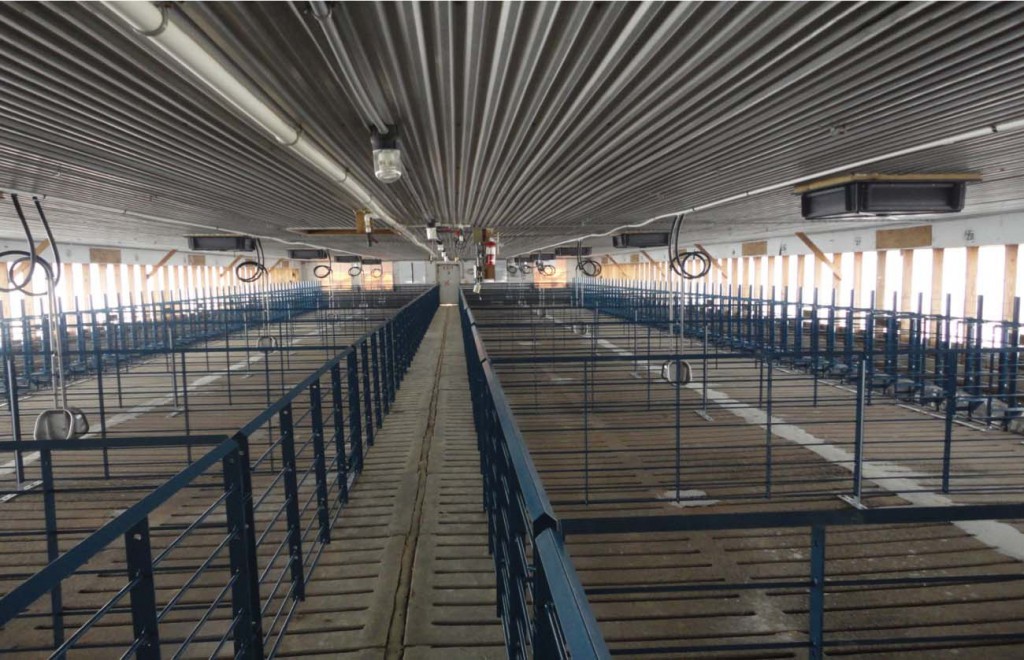
Murphy-Brown’s North Division has completed one of the largest stall to group housing conversions in the industry. All the company farms have been converted to group housing over the last four years; 58,000 sows in total. Keith Allen, General Manager of the North Division, discussed the conversion.
Keith, how did you decide on the type of group system?
“Long before we announced our conversion plans, we toured several types of housing systems abroad; ESF (Electronic Sow Feeding), Free-Access stalls and Pens with feeding stations or Stanchions. We felt stanchions would require the least amount of cost and would be easiest to manage. The results four years post conversion support that decision.”
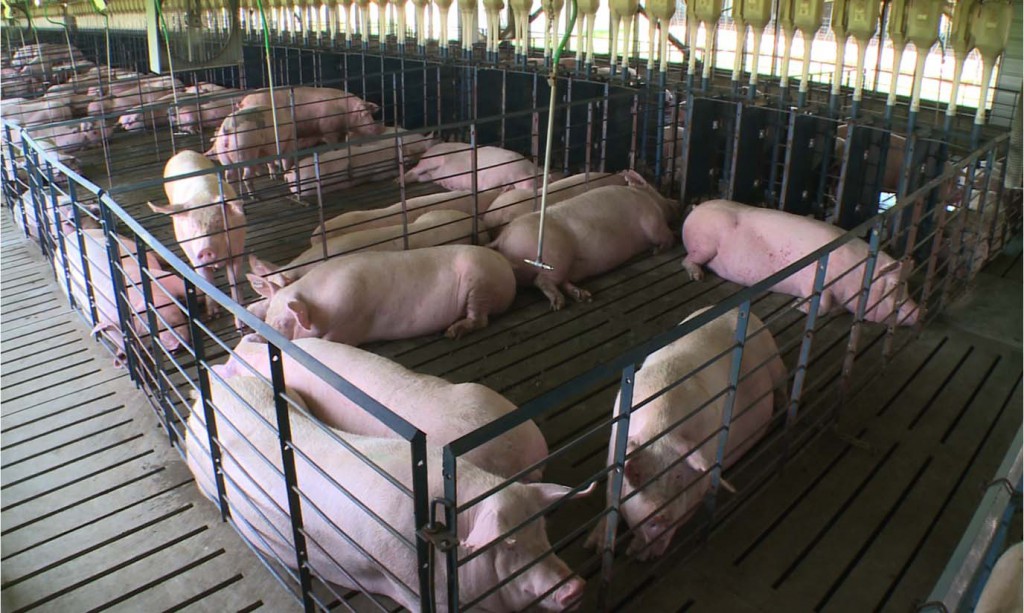
Can you explain that a little further?
“Our production records validate improvements for any metric you can compare, pig/born, pigs weaned, etc. The company farm production records rank better than most contract growers with stall gestation. Sow mortally is neutral when compared to traditional stall operations in the system. Fighting is less than we expected. Although we anticipated higher feed consumption in gestation, it also has remained neutral.”
Do you manage any other types of group housing systems to compare stanchions to?
“We have a large 10,500-sow unit with ESF feeding stations. The repair and maintenance of the feeding stations requires a full time employee on this operation. There is extra labor involved with the management of the animals. Every day the computer system prints a list of animals that didn’t record entry into the ESF from the previous day. An employee must locate those animals and identify why; Is she sick? Did she lose her tag? Is the feeding station in need of repair? Etc.”
“We just don’t have the extra labor costs or the maintenance in our stanchion type barns.”
“Free access stalls don’t have the same issues, but are more expensive to construct and present an increased opportunity of equipment failure with the gate latching mechanism. There is also a chance an employee inadvertently or purposely could lock the animals in the stalls, and then we really don’t have loose pen housing anymore.”
How did the transition go on the farms?
“The transition was seamless; our employees now prefer stanchions to the stall system we used before.”

What are basic design requirements you used?
“We designed the pens to hold six sows with 24 square feet per animal; there is one feeding stanchion per sow. The stanchions are 24” wide, and the dividers are 18” long. The length of the divider is important; this divider should be long enough to extend past the shoulders. By extending past her shoulder, she feels more comfortable and secure when eating.”
“The facility design provides breeding stalls to house sows for 35 to 42 days post insemination. After preg-checking, sows are grouped by size and moved to the pens.”
“An additional 3-5% of stalls have been added in the Group Housed gestation barns to provide critical care space for any animals that may require extra care or must be removed from the pens.”
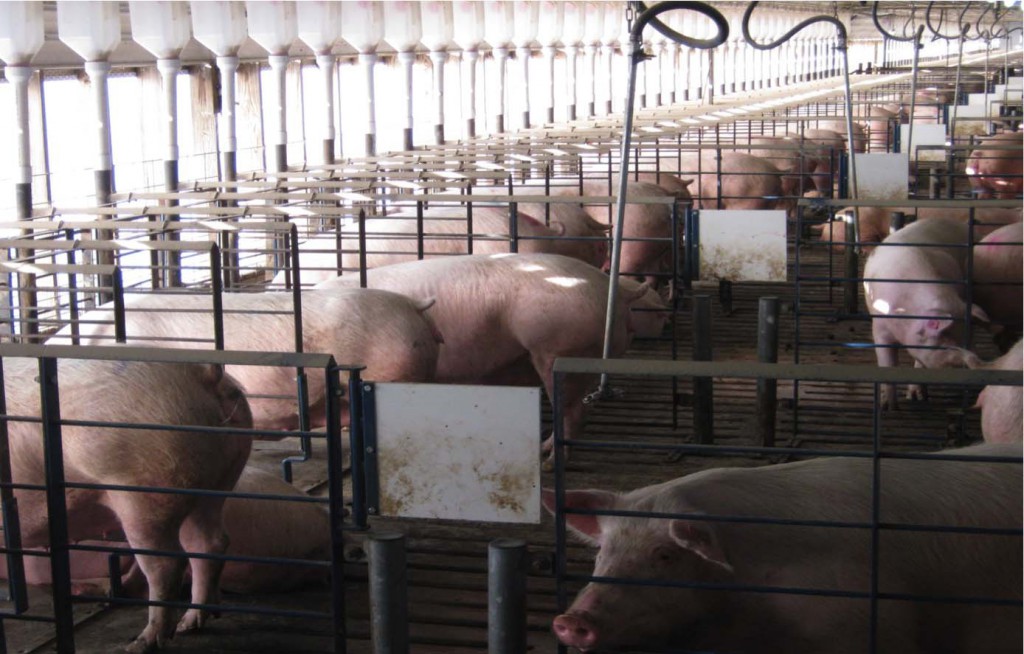
Have you made changes to the design over time since beginning the conversion?
“Yes, our original layouts allowed for 7% extra stalls in the group housed gestation barns…..we have since cut that back to only 3-5%.”
“We have also realized it is unnecessary to have an alleyway between rows in group housed gestation. We simply mount the stanchions and sow feed drops head to head. One of the things you lose with group housing is the ability to regulate individual feed intake…..you manage by pens, so there isn’t a lot of adjustment to the drops.”
“We also have added “Access Doors” to the pen dividers to make it easier to walk from pen to pen. These consist of two posts set far enough apart that a person can squeeze through with a swinging solid divider on top to prevent the animals from attempting to go over the opening. We no longer have to climb pen dividers to check sows.”
How have the changes been viewed by Smithfield’s customers?
“I have personally toured many representatives from large food companies through our remodeled facilities. These companies made public commitments to securing pork from “stall-free” producers by a named date….they are listening to the consumer and committed to their long term Sustainability Programs. In every case, the reps remarked how well cared for the animals seemed to be and remarked how clean the facilities were. We think we have answered their concerns with this type of group housing.”
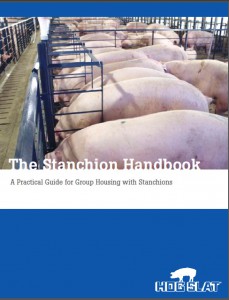
The handbook begins by comparing merits of different systems available for group housing. Complete with illustrated pictures of equipment and diagrams of building layouts, this 16 page handbook contains practical details needed to build new sow housing or convert existing stalls to group housing.
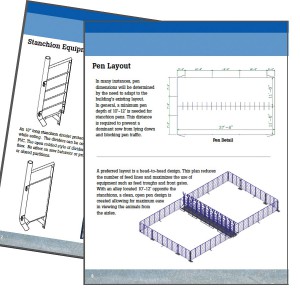
Download your FREE Stanchion Handbook
I was scrolling the web for information on sow housing and ran across this piece authored by John J. McGlone, PhD at Texas Tech University. Here are some highlights:
First mention of sow stalls was in 1807 in Baxter, England.
Lubbock Swine Breeders housed sows in stalls starting in 1964/1965. These stalls featured a sand area behind them.
To read the full article, click the link below:
The Crate (stall, case,cage, box, etc): Its History and Efficacy – John J. McGlone, PhD
I found it to be interesting reading and hope you do too.
Official Swine ID – FAQ (Frequently Asked Questions)
With the USDA Animal Disease Traceability (ADT) rules now in place there is an increasing emphasis on livestock traceability within State and Federal agencies and the livestock industry. More and more producers are hearing about Official ID products and specifically to this article, how it pertains to swine.
There are two main categories when it comes to Official ID for Swine. There are “840” tags and there is the “Swine Premises Tag”. Below are the details and common questions for both.
840 Tags:
What is an 840 tag?
840 tags are USDA approved tags for official individual animal identification. They will have a unique 15 digit number that always starts with “840” which is the country code for the United States. A manufacturer has to be approved by the USDA to produce a specific 840 tag.
What is a common use for 840 tags in Swine?
Increasingly 840 tags are being required for Swine Shows, State and County Fairs and Auctions. They can also be used for Interstate Commerce.
How do I purchase 840 tags?
You must have a registered Premises ID before you can purchase 840 Tags. If you don’t have your Premises ID you should start with contacting your State Animal Health Agency. You can find your respective state’s contact information at the following link: http://www.usaha.org/Portals/6/StateAnimalHealthOfficials.pdf
Once you have your Premises ID you can order your 840 tags and tag applicator by Destron Fearing from Hog Slat. (See chart below)

Swine Premises (PIN) tags:
Why is a Swine Premises tag commonly referred to as a PIN tag?
Swine Premises tags are official location identification for cull breeding stock (cull sows and boars). The minimum requirement is for them to be used on cull breeding animals just prior to entering harvest channels from their farm of origin.
What does PIN stand for?
Premises Identification Number. It is a unique 7 character alpha-numeric national site identifier.
Can I use them for identifying feeder pigs/weaner pigs for movement and/or show pigs?
No, they are for use with animals in the breeding herd only.
Why was January 1st, 2015 important for Swine Premises tags?
That was the date that the swine industry and packers/processors agreed on to make PIN tags a requirement of sale. If a producer wants to receive full value for their cull breeding animals from that date forward, the animals need an Official Swine Premises tag in their ear before leaving their farm of origin.
When should I apply the PIN tags to my animals?
Most producers are applying them to new breeding animals as they enter the breeding herd and are using it as their management tag. You may also apply them when culling an animal from the farm, just prior to the animal entering harvest channels.
How do I purchase Swine Premises (PIN) tags?
You must have a registered Premises ID (National 7 character alpha-numeric ID) before you can purchase Swine Premises Tags. If you don’t have your Premises ID you should start with contacting your State Animal Health Agency. You can find your respective state’s contact information at the following link: http://www.usaha.org/Portals/6/StateAnimalHealthOfficials.pdf
Once you have your Premises ID you can order your Swine Premises tags and tag applicator by Destron Fearing™ from Hog Slat. (See chart below)
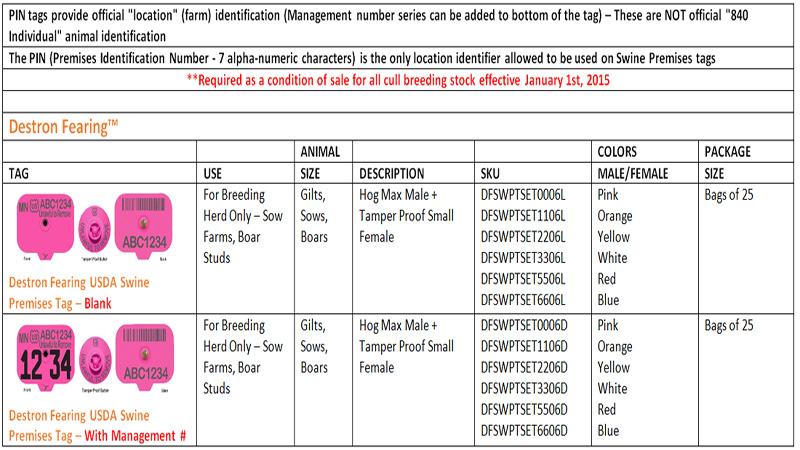
Hog Slat also offers a wide selection of Destron Fearing™ livestock identification tags for your cattle, swine, sheep and goats. Click here to shop the entire line of animal identification tags and accessories.
- 2025
- 2024
- 2023
- 2022
- 2021
- 2020
- 2019
- 2018
- 2017
- 2016
- 2015
- 2013












 Україна
Україна Méjico
Méjico


